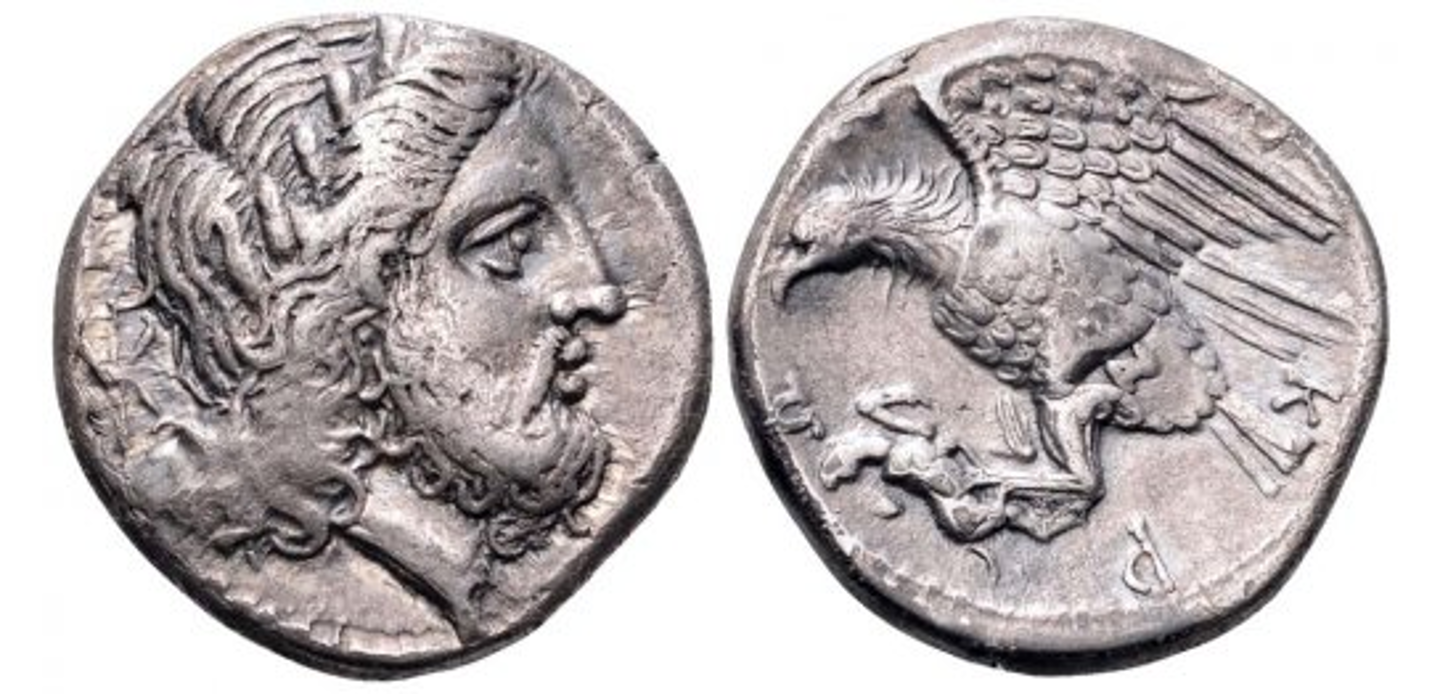2090 - Locri Epizephyrii (nomos Zeus/eagle) over Corinth (Pegasus/Athena) (Roma Numismatics, EA 21, Oct. 2015, 51): Difference between revisions
From SILVER
No edit summary |
No edit summary |
||
| Line 21: | Line 21: | ||
|Overstruck obverse description=Pegasus. | |Overstruck obverse description=Pegasus. | ||
|Overstruck reverse description=Head of Athena (visible on reverse: AP monogramm) | |Overstruck reverse description=Head of Athena (visible on reverse: AP monogramm) | ||
|Remarks=The host coin was apparently a Corinthian-type stater and perhaps identifiable to issue. | |||
}} | }} | ||
Revision as of 15:24, 16 June 2023
400 BCE - 300 BCE | ΛΟΚΡΩΝ
Location/history
| Sale(s)Sale(s) ᵖ: | Roman Numismatics, EA 21 (31/10/2015), lot 51 ; Pegasi Numismatics on Vcoins, (24/04/2018) | |
Overstriking coin
Description
| ObverseInscription or printing placed on the obverse.: | Head of Zeus right, wearing laurel wreath. In left field, thunderbolt or monogram. | ReverseInscription or printing placed on the reverse.: | ΛΟΚΡΩΝ (Greek) Eagle flying left, dead hare in talons. Border of dots. |
Mint and issuing power
| MintIdentifies the place of manufacture or issue of a numismatic object.: | Locri Epizephyrii | Ancient regionAncient region. | Magna Graecia (Bruttium) | Modern countryModern country: Italy | AuthorityIdentifies the issuing power. The authority can be "pretended" when the name or the portrait of X is on the coin but he/she was not the issuing power. It can also be "uncertain" when there is no mention of X on the coin but he/she was the issuing power according to the historical sources: |
Chronology
| FromIdentifies the initial date in a range assigned in a numismatic context. 400 BCE toIdentifies the final date in a range assigned in a numismatic context.. 300 BCE | Classical 480-323 BC |
Physical description
| MetalThe physical material (usually metal) from which an object is made.: Silver |
WeightWeight of the numismatic object (in grams). in grams: 7.527.52 g <br />7,520 mg <br /> | DenominationTerm indicating the value of a numismatic object. Examples: tetradrachm, chalkous, denarius.: didrachm / nomos |
AxisDescribes the directional relationship between the obverse and reverse of a numismatic object.: 44 mm <br />0.4 cm <br /> |
| DiameterDescribes diameter of an object (in mm).: 2020 mm <br />2 cm <br /> | StandardStandard.: Achaian | ||
References
| Coin referenceReference of the Coin: | Coin series referenceReference to coin series study: | SNG ANS/Sylloge Nummorum Graecorum1SNG ANS/Sylloge Nummorum Graecorum, USA, The Collection of the American Numismatic Society (9 vols.), New York, 1969-1998, n° 519., HN Italy2HN Italy, n° 2319-2328., HGC 13HGC 1, n) 1565 | |
| Coin series web referenceCoin series web references: | |||
Overstruck type
Description
| ObverseInscription or printing placed on the obverse.: | Pegasus. | ReverseInscription or printing placed on the reverse.: | Head of Athena (visible on reverse: AP monogramm) |
Mint and issuing power
| MintIdentifies the place of manufacture or issue of a numismatic object. ᵖ: | Ancient regionAncient region. ᵖ | Modern countryModern country: | AuthorityIdentifies the authority in whose name (explicitly or implicitly) a numismatic object was issued. ᵖ: |
Chronology
| FromIdentifies the initial date in a range assigned in a numismatic context. toIdentifies the final date in a range assigned in a numismatic context.. | periodTime period of the numismatic object. |
Physical description
References
| Coin type referenceReference to coin series study ᵖ: |
Additional data
| Frequency of overstrikesFrequency of overstrikes: | Level of confidenceLevel of confidence of the identification: | ||
| RemarksRemarks: | The host coin was apparently a Corinthian-type stater and perhaps identifiable to issue. | ||
References
- ^ SNG ANS/Sylloge Nummorum Graecorum
- ^ Rutter N. Keith et alii (eds.) (2001), Historia Numorum Italy, London, xvi, 223 p., 43 pl.
- ^ Hoover, Oliver D. (2018), The Handbook of Greek Coinage Series, Volume 1. Handbook of Coins of Italy and Magna Graecia, Sixth to First Centuries BC., Lancaster-London, 2018, lxi, 527 pages, 23 cm
